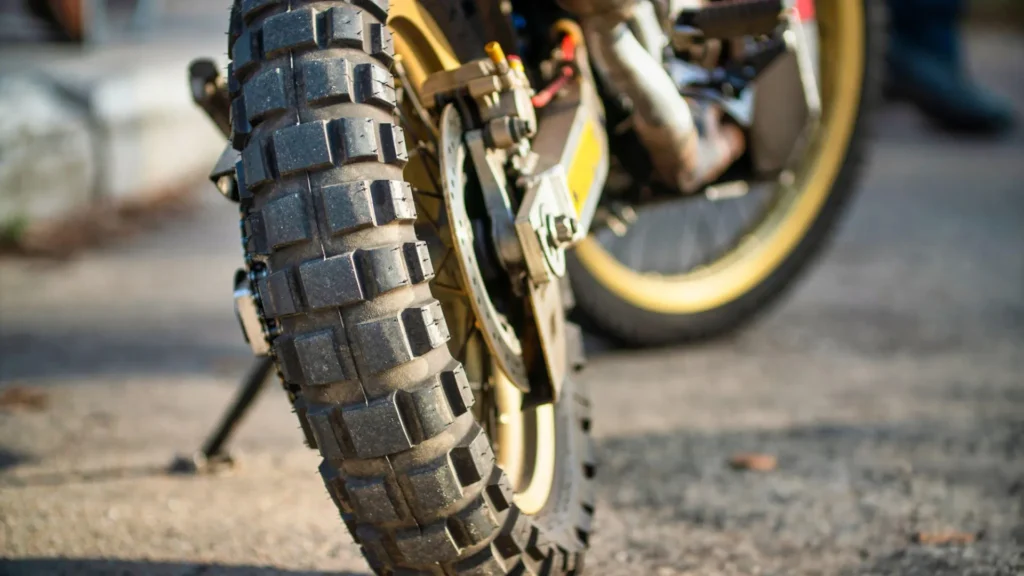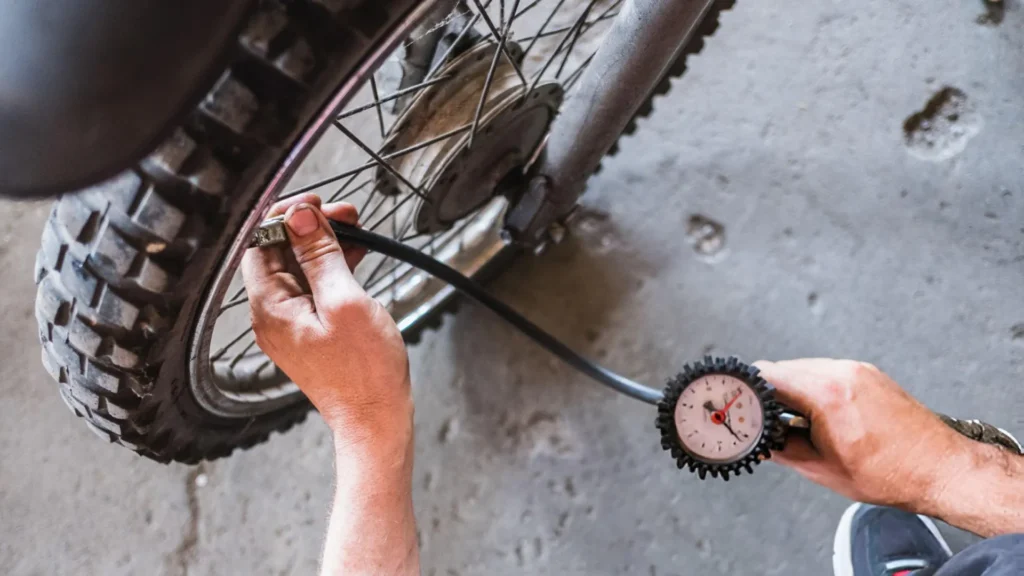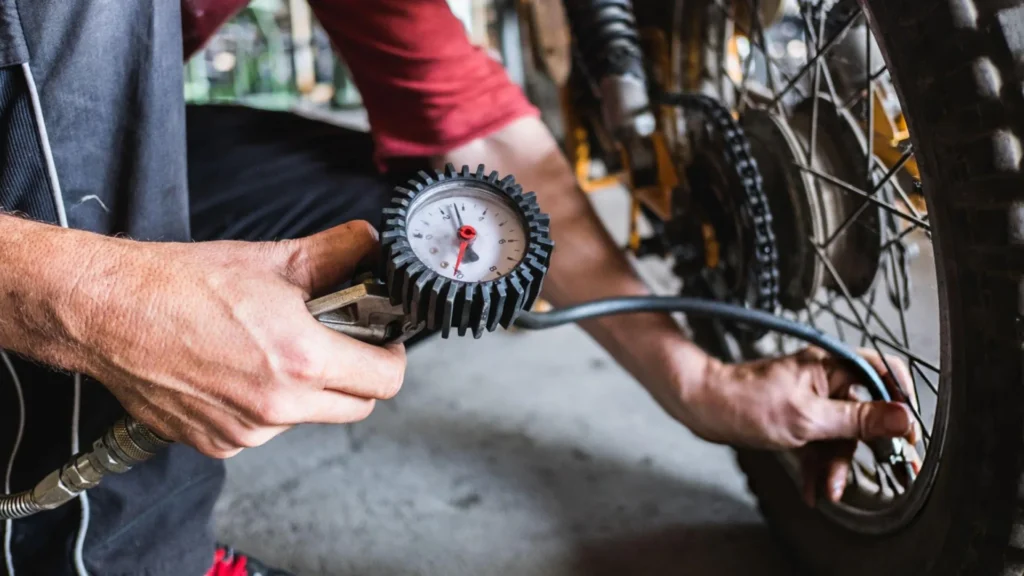Whether you’re blasting through dry trails or squeezing through those sharp motocross bends, dirt bike tire pressure isn’t just some small number on a gauge; it decides how your whole ride feels. When dirt bike tire pressure is set correctly, your grip improves, the bike stays balanced, and the tires don’t wear out too quickly. But mess it up, and you’ll feel it fast. Set the PSI wrong? The ride feels unstable, with less control, increased wear, and a higher chance of a dirt bike flat tire.
This 2025 guide breaks down the essentials of air pressure for dirt bike tires. From picking the right air pressure for each terrain to keeping your tires in check before every ride. Quick tips, no fluff.

Table of Contents
ToggleWhy Dirt Bike Tire Pressure Matters
Dirt bike tire pressure is far from a peripheral concern; it constitutes the very foundation of dynamic handling and mechanical harmony. Achieving the optimal PSI for dirt bike tires is not merely a technical adjustment; it directly governs how your machine interfaces with the terrain beneath it.
With precise calibration, dirt bike tire air pressure allows your tires to deliver:
- Enhanced traction – Crucial when traversing unstable substrates like sand, mud, or fragmented rock
- Refined suspension synergy – Allowing forks and shocks to function without absorbing disproportionate stress
- Extended tire longevity – Mitigating premature tread degradation and lowering the probability of abrupt failure
- Superior handling acuity – Facilitating sharper cornering, more stable landings, and consistent responsiveness
But when is that PSI’s even a little off? Your tires might bounce wildly or simply sink into soft ground. And the “perfect” pressure? It depends on terrain, your weight, and sometimes even the weather. So not something you just set once and walk away from.

Key Factors That Influence Dirt Bike Air Pressure
Before you reach for the pump, consider these important factors that affect psi for dirt bike tires:
Rider Weight & Bike Size
Heavier rider? You’ll likely need to raise the pressure a notch, keep the rims protected, and the ride from feeling too spongy. If you’re lighter, slightly reducing PSI gives you added traction without compromising too much on control. It’s all about striking the right balance between absorption and response.
Terrain Considerations
Getting tire pressure right isn’t just about what feels good; it changes how the bike performs on different surfaces. Pressure adjustments can shape how your ride responds out there.
● Motocross (MX):
MX tracks come with jumps, corners, and quick changes. Most riders stick to something between 12–14 PSI, depending on the soil. A bit more motocross tire pressure helps take on those impacts better, especially when landing hard. But if it’s too much, cornering starts to suffer. The bike feels jumpy, not settled. Tires used here usually have tough sidewalls, made to keep their shape under stress. The goal is to have just enough firmness to take hits, but not so much that it loses grip when leaning in.
● Enduro:
Enduro rides mix all kinds of ground, rocky patches, roots, climbs, and wet spots. That’s why riders tend to lower pressure to around 8–11 PSI. With that, tires flex more and adjust to uneven surfaces. It brings better traction where needed. Rim locks or mousse inserts often help avoid flats. When the pressure’s lower, the tire sort of wraps around the ground, giving more control. Softer tires with deeper tread are common here, and sometimes dropping a bit more at the rear gives better push through loose sections.
● Dual Sport:
This one needs a bit of both worlds. On-road use needs higher dual sport tire pressure, around 18–22 PSI, for grip and tire life. Go too low and the ride gets sloppy. But off-road, that setup’s too hard. The tire can’t grab properly. That’s why many dual sport riders go for middle-ground settings, like 16 PSI, and keep tools to adjust as needed. 50/50 tires help here too, they’re made to handle both road and dirt decently. It’s all about finding what works best depending on where you’re headed next.
Different terrain needs its tire pressure to keep things balanced. Whether it’s Motocross, Enduro, or Dual Sport riding, fine-tuning that PSI is one of the easiest ways to keep things smooth, controlled, and safe.
Climate & Temperature Effects
The dirt bike tire pressure doesn’t stay still; temperature pulls it in both directions. On colder days, pressure drops, making the tire feel underinflated. In the heat, it rises, sometimes pushing things a little too far. That’s why you always check dirt bike tire psi when the tires are cold; it gives you the most accurate baseline before the ride begins.
Recommended PSI Settings by Terrain & Riding Style
Your ideal PSI varies depending on where and how you ride. Use the chart below to find your sweet spot:
| Terrain / Riding Style | Front Tire PSI | Rear Tire PSI |
| Motocross | 12 – 13 PSI | 12 – 14 PSI |
| Enduro / Trail | 8 – 12 PSI | 10 – 13 PSI |
| Dual Sport (Street & Dirt) | 16 – 18 PSI | 18 – 20 PSI |
| Sand / Mud | 8 – 10 PSI | 8 – 10 PSI |
| Rocky / Hard Terrain | 13 – 14 PSI | 14 – 16 PSI |
This dirt bike tire pressure chart is just a starting point. The ideal PSI changes depending on a few key details:
- Tire type – A 2.50-16 won’t react the same as a 100/90 x 19.
- Bike model & weight – Heavier setups usually need a bit more pressure.
- Trail conditions – Wet, soft, or rocky terrain shifts everything.
Lower the pressure in sand or mud to boost traction. For firmer, hard-packed trails, go a little higher for added stability and control.

How to Check and Adjust Dirt Bike Tire PSI
You don’t need much, just the right tools and a few minutes before each ride:
Required Tools:
- A high-precision pressure gauge, digital types typically deliver greater accuracy
- An efficient air compressor or a robust manual pump for adjustments
- Extra valve caps in case of loss or deterioration
Procedure:
- Begin with cold tires; heat from recent use can distort dirt bike tire PSI readings.
- Remove the valve cap carefully, ensuring the stem remains clean.
- Attach the pressure gauge and observe the reading without delay.
- Inflate or deflate incrementally, aligning pressure with terrain-specific requirements.
- Confirm accuracy with a second reading.
- Replace the valve cap securely to maintain pressure integrity.
Frequency of Checks:
- Conduct a dirt bike air pressure check before every ride, especially when transitioning between different surface types.
- Inspect at least once weekly, even during idle periods. PSI for dirt bike tires naturally declines over time due to atmospheric variables.
Staying consistent with checks and adjustments not only extends tire life but also gives you better control, grip, and confidence every time you ride.
Common Tire Pressure Mistakes to Avoid
Over-Inflation
- Reduces contact with the ground
- Causes poor handling and bounciness
- Can wear the center of the tire faster
Under-Inflation
- Risks include pinch flats and rim damage
- Unstable cornering and reduced stability
- Leads to uneven tire wear

PSI Doesn’t Fit Your Tire Type
Running identical pressure across different tire sizes ( e.g., 100/90 x 19 front tire pressure vs 2.50-16 dirt bike tire) is a common misstep. Each tire’s build reacts differently under load and terrain, so matching PSI to its exact spec and riding conditions isn’t just smart, it’s necessary.
Want to get it right? Dive into our full Dirt Bike Tire Guide and make sure you’re using the correct dirt bike tire PSI chart for your setup.
Maintenance Tips for Dirt Bike Tire Longevity
Your dirt bike tires take constant punishment, so keeping them in top shape isn’t optional; it’s essential.
Weekly PSI Routine
- Always use precise tools
- Adjust for shifts in weather and terrain
- Don’t skip the front and dirt bike rear tire consistently
Know When It’s Time to Replace
- Sidewall cracks or visible damage
- Flattened knobs mean reduced grip
- If they’re pushing two years? The rubber may already be losing its life
Smart Storage
- Keep them indoors, away from direct sunlight
- Avoid damp areas or chemical exposure
Want to dig deeper? Our blog’s loaded with practical tire care tips to keep your ride dialed in for longer.
Conclusion
The dirt bike tire pressure is not just digits on a gauge. It shapes how your bike feels beneath you, how steady it lands, and how it holds up when the terrain gets rough. A small tweak can shift the whole ride.
Your weight changes it. So does the trail, and even the weather. That’s why air pressure for dirt bike tires needs to be checked, not once, but often. The better it’s set, the more in control you stay.
At BSEMotor, we keep it simple. Quality tires, dependable tools, and tips that don’t waste your time, just help you ride better, longer.
Set the PSI that suits your trail. Keep your control tight.
Visit BSEMotor to shop premium dirt bike accessories and read more expert tips on our blog.
FAQs
1. What if I don’t check my dirt bike tire pressure regularly?
If you skip dirt bike tire pressure, things go off fast, with less control, quicker wear, and flats showing up when you least expect. PSI tends to drop over time, more so with weather changes. A simple check before the ride saves a whole lot of trouble later.
2. Is there one PSI that works for every dirt bike tire?
Not really. The right dirt bike tire PSI changes with terrain, rider weight, and the size of your tire. What works on one setup might feel way off on another. Always go by a proper dirt bike tire pressure chart; it keeps things accurate.
3. Why do motocross and enduro bikes use different pressures?
Motocross needs pressure that handles jumps and tight turns; balance is key. Enduro? It’s more technical, more uneven. Lower PSI gives better traction when trails get rough or loose.
4. Can wrong PSI damage the tire or inner tube?
Yes, it can. Overinflated tires ride stiff and might damage the bead. Underinflated? You’re looking at pinch flats and uneven wear, especially if the terrain’s rough. Getting it right saves both the tire and the tube in the long run.
5. Does elevation affect dirt bike tire pressure?
It does. Higher up, the outside air pressure drops, which puts more stress inside the tire. When riding in mountains or high altitudes, it’s a good move to adjust your air pressure for dirt bike tires slightly to match those conditions.
